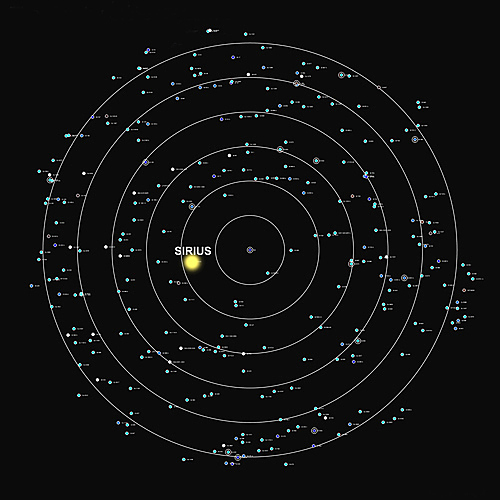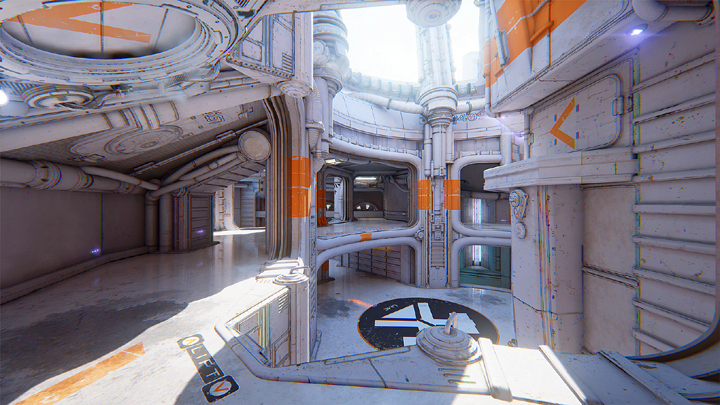
DISTANCE: 8.6 light years from Sol
NEIGHBORING SYSTEMS: Procyon 5.2 lys Epsilon Eridani 7.8 lys Alpha Centauri 9.5 lys
SIRIUS is a binary star system which consists of two white dwarfs with an average distance between them of only 19.8 AUs. Sirius A, nicknamed the “Dog Star”, is over 20 times brighter than Sol and is orbited by two gas giants, a large asteroid field, and a thick cloud of dust debris. Sirius B, nicknamed the “Pup”, is the smaller of the two stars and, although there are no planets in orbit, the local region is permeated by a thick cloud of dust. Under constant bombardment by meteorites and comets; the entire system has over seven times the iron abundance of Sol and is rich in Teslium ore.
ODIN is the second planet in orbit around the primary star and is the larger of the two gas giants. It is made up primarily of hydrogen, helium, and ammonia with slight traces of methane and has an intense internal heat source that radiates an enormous amount of energy of its own. Slightly larger than Jupiter, it is frequently subjected to powerful bursts of radiation from its host star which causes massive storms to circulate in the upper atmosphere. Odin has a total of 81 moons in orbit, the largest of which, called Donar, has the highest concentration of Teslium deposits in the entire system.

Claimed as commercial property by the Reinhold Corporation in 2138, the Sirius system was only the second one outside of Sol to be populated by Humans. Due to the fact that it had no planets or moons that were suitable for long-term habitation, this corporation utilized its advanced engineering skills to construct an orbiting space station just outside of Odin’s main radiation belts. FENRIR STATION soon became both the primary base of operations for their mining industry and the permanent residence of the company employees and their families as well.
The Sirians, as the outpost’s inhabitants eventually came to call themselves, are typically very intelligent and highly innovative. They are generally viewed as being efficient, methodical, and strictly rigid in their adherence to procedure and protocol. Due in part to the exclusive nature of the outpost itself, as well as the long-term psychological effects of living in close quarters, Sirians tend to be extremely reserved and seem rather cold and unapproachable. Yet, this apparent societal isolationism has led to a far different extreme in their social lives. They frequently attend large private gatherings where they arrive in costume to maintain their anonymity. Guests of these social events are encouraged to release their inhibitions and no form of sexual interaction is considered taboo. This duality in their natures is rarely witnessed by outsiders and only shared with those who have earned a great deal of trust; hence the expression, “What happens at Fenrir Station stays at Fenrir Station.“
Although further occupation of this system has remained rather limited due to a lack of available real-estate, over the years dozens of additional modular units have been connected to the station including several hydroponic and agricultural units for growing their own food under the intense sunlight of two energy-rich stars. According to the official census in 2233, FENRIR STATION now provides residential and workplace environments for nearly 625,000 individuals.

Because this system was essentially claimed for the sole purpose of harvesting resources, the inhabitants were long regarded simply as company employees rather than traditional colonists. They had no provisional government and were under the direct authority of the Mining Guild for nearly 60 years. A Guild Baron was appointed as the regional administrator to regulate and oversee the entire operation. Since the initial discovery of large quantities of Teslium ore, numerous extraction facilities have been established on several of Odin’s larger moons. Over the years, this outpost has supplied a variety of valuable resources to Earth and many of its colonies as well to become one of the most lucrative mining communities ever established.
By 2152, the Reinhold Corporation had increased its profits to such an extent that it took on a second interstellar project and established a permanent outpost in the Procyon system. There, they found yet another seemingly endless reserve of Teslium ore which gave them an even greater monopoly on this valuable resource. Due to its frequent business dealings with Bourne Industries, the Reinhold Corporation had developed close ties with Alpha Centauri and, in 2168, they combined their efforts to colonize the Groombridge 1618 system as well.
Within a single generation, the residents of FENRIR STATION had completed construction on three separate arrays located in close proximity to the primary star. Each of them was enveloped in high-absorption stellar panels to collect the nearly limitless amounts of energy. The DAGR array was the first of these structures and functioned as the outpost’s main stellar energy storage facility. The FREYJA array used the energy it collected to power their primary processing plant for refining Teslium ore. The LOGI array was built to provide energy for their orbiting shipyard where they began building their own private fleet of freighters and mining vessels.

When the Human race first encountered the Zendathu in 2182, the Reinhold Corporation doubled its security and began to relocate all of its commercial operations out of the Sol system in order to make its interstellar properties its primary concern. This company also increased its overall workforce and began construction on its very own fleet of battlecruisers to prepare for any possible future attacks. As the war between the two species began and one system after another came under repeated attacks, the Sirian Defense Fleet fought alongside the Centauri Navy on countless occasions and proved themselves to be a valuable asset in the fight against the Zendathu.
After the war, the UEC began to enforce several unpopular policies upon many of its colonies. These blatant acts of intimidation eventually led the Reinhold Corporation to protest by ceasing all further shipments to Earth. The UEC warned that, if shipments didn’t resume immediately, a permanent military presence would be assigned to the outpost and martial law would be established. Fearing a corporate takeover and knowing that their security forces alone were no match for SolCorp’s massive fleet, the Sirian people turned to their allies in the Alpha Centauri system for support. Representatives from Sirius, Alpha Centauri, Procyon, and Groombridge 1618 were chosen to assemble together on Beta Prime where they signed “The Centauri Accords” which officially declared their complete separation from Earth’s corporate empire. These accords were also the catalyst in creating the Centauri Union which not only merged these colonies together under one interstellar government, but provided military defense and economic support to all of its members.
To this day, the Sirians remain rather indifferent towards outsiders unless they are directly involved in profitable business arrangements. They tend to be direct and outspoken to the point of seeming almost rude, yet continue to be one of the most influential of Human societies out of over a dozen inhabited systems.